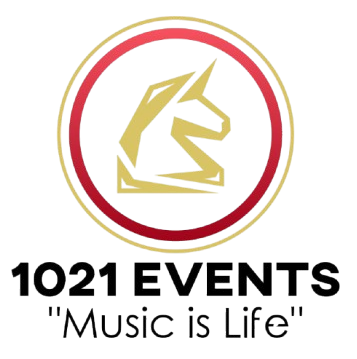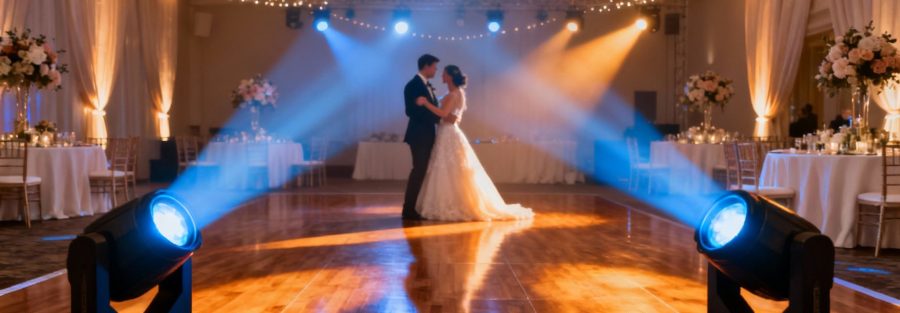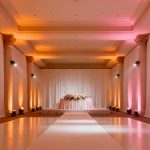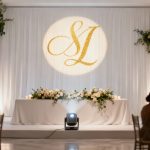Let's be real for a second. The right DJ lights for a wedding are what take a reception from just a nice dinner to a full-blown, unforgettable party. This is the secret ingredient that cranks up the energy, makes your wedding photos pop, and convinces even your shyest uncle to bust a move on the dance floor.
Why Your Wedding Lighting Creates the Vibe
Lighting is so much more than just a few colorful dots dancing on the wall. It’s about building a whole visual experience—one that sets the emotional tone for the entire night. Think about it: a flat, brightly lit room feels like a conference hall. But a space washed in carefully chosen colors? That feels romantic, intentional, and alive. From the second your guests arrive, the lighting tells them exactly what kind of night they're in for.
This isn't just a small detail, either. The wider stage lighting market, which absolutely includes gear for weddings, is a massive industry. It was valued at a whopping USD 2.52 billion in 2022 and is only getting bigger, with weddings being a huge reason for that growth.
Mood, Energy, and Memories
The real magic of professional DJ lighting is how adaptable it is. It ebbs and flows with the energy of your wedding, creating completely different feelings for each part of the evening. You can have a soft, warm amber glow during dinner that encourages conversation, and then—boom!—switch to vibrant, beat-synced lights that tell everyone it's time to party.
This infographic really shows how all the different lighting pieces come together to shape the wedding experience.
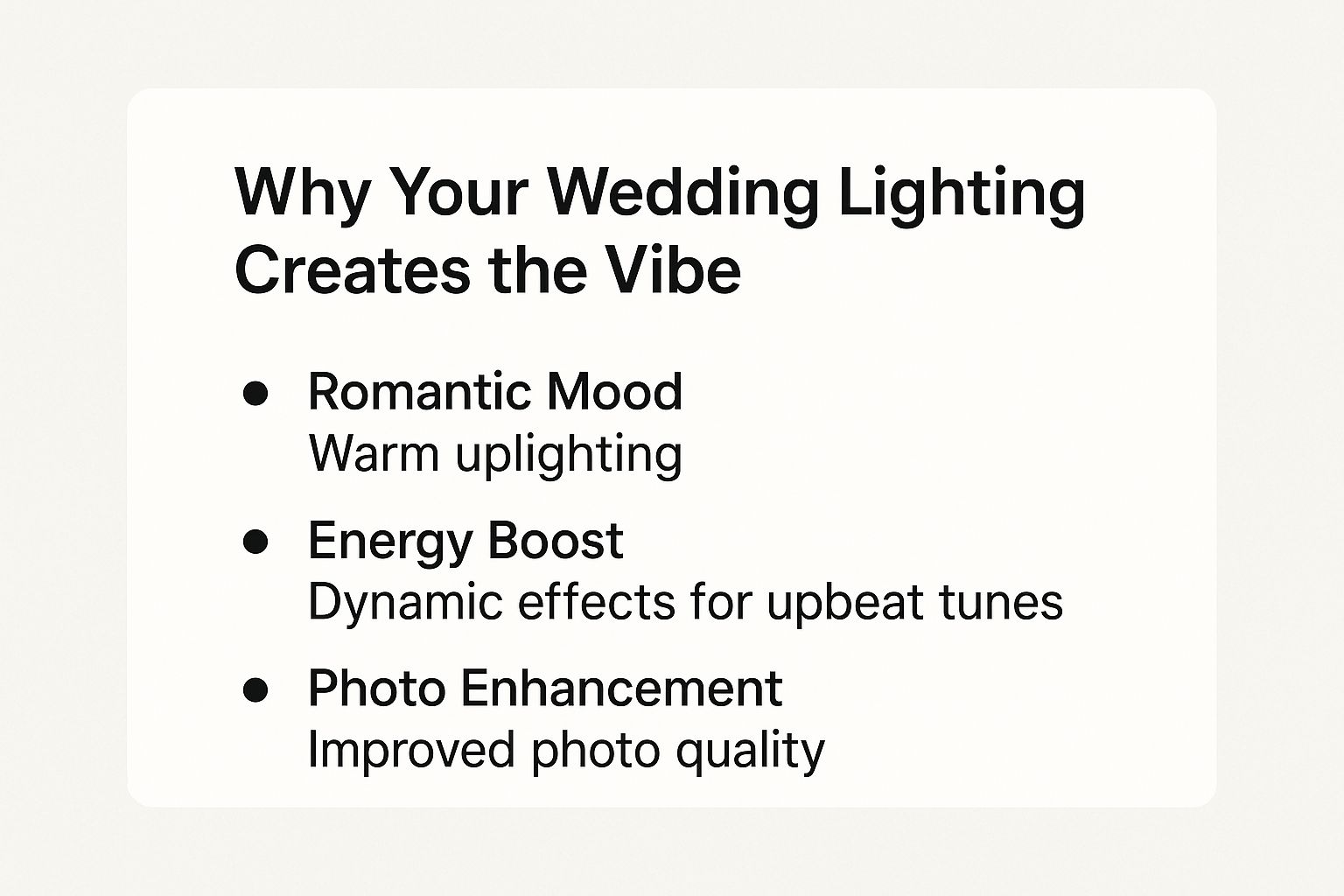
As you can see, it's the combination of uplighting, those fun dynamic effects, and accent lights that truly creates the perfect mood and guarantees your photos will look incredible.
Great lighting also becomes your photographer's best friend. It adds depth, gets rid of harsh shadows, and gives every candid shot a beautiful, cinematic quality. The way visuals can completely redefine a room is amazing; you can even see how professionals use AI tools for virtual staging and space transformation to totally change a space's look and feel.
Key Takeaway: Professional DJ lights aren't just some optional add-on. They are a core part of your wedding's design. They guide your guests' attention, build atmosphere, and make the whole celebration more fun and memorable for everyone there.
When you invest a little thought into your lighting, you're really investing in the entire vibe of your big day. To see just how much one technique can do, take a look at our guide on the transformative power of uplighting for weddings.
Understanding Your Wedding Lighting Options
Stepping into the world of event lighting can feel a bit like learning a new language. You hear terms like "wash," "gobo," and "moving heads," but what do they actually mean for your big day? Getting a handle on the different types of DJ lights for a wedding is the first real step toward creating the exact atmosphere you've been dreaming of.
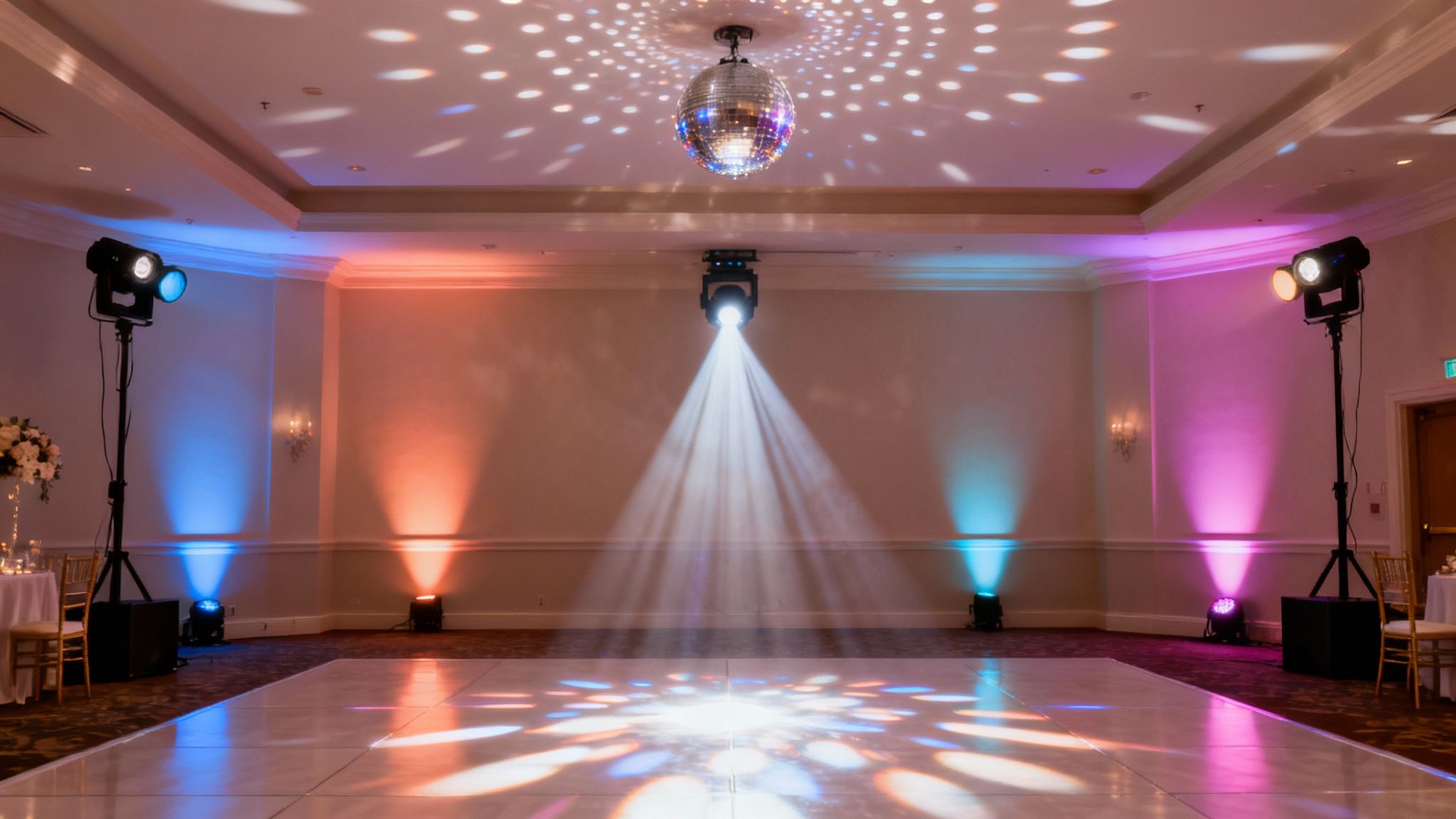
Each fixture really has a specific job. When you start combining them, you're essentially building layers of light that can completely transform a venue. Let's break down the most common options so you can chat confidently with any DJ or lighting pro.
Foundational Lighting for Ambiance
This first group is all about setting the overall mood of the room. These lights aren't necessarily for the dance floor itself, but they make the entire space feel warm, elegant, and pulled together.
-
Uplighting: This is hands-down the most popular choice for weddings, and for good reason. These are small but powerful lights placed on the floor, shooting beams of colored light up the walls or highlighting architectural details like columns. They can instantly paint a room in your wedding colors, turning a plain banquet hall into something truly special.
-
Wash Lights: Think of these as a close cousin to uplighting. Wash lights are designed to "wash" a large area with soft, even color. They're like the broad paint strokes that create the foundational color palette for your reception space.
Pro Tip: When picking colors for uplighting, think about your venue's existing decor. A warm amber or soft white can really enhance a room's natural beauty. But if you want a more modern, energetic feel, a deep blue or magenta can completely redefine the space.
Dynamic Lighting for the Party
Once dinner is over and the music kicks up a notch, you need lighting that brings the energy. This is where dynamic, or "intelligent," lighting comes into play. These fixtures are the fun ones—they're designed to move, change color, and sync up with the beat of the music.
For a deeper dive into making this part of your reception unforgettable, check out our complete guide on choosing the best lights for your dance floor.
-
Moving Heads: These are the real workhorses of any great dance party. Moving heads are super versatile lights that can pan around, tilt up and down, change colors, and even project patterns (we'll get to those!). They create those sweeping beams of light across the room that build excitement and get guests out of their seats.
-
Effect Lights: This is a pretty broad category that covers everything from the classic mirror ball to modern laser effects. While you want to be careful with lasers so they don't overwhelm your photos, they can create a stunning "wow" factor when used at just the right moments.
Personalization and Detail Lighting
Finally, some lights are all about adding that custom, personal touch. They're used to draw attention to the specific details you've spent so much time planning.
Gobos and Monogram Projections
A gobo is basically a small stencil that goes inside a light fixture, allowing you to project a custom image. The most popular use for this is a monogram projection, where you can display your initials or wedding date right on the dance floor or a prominent wall. It’s a simple addition that makes the whole lighting design feel uniquely yours.
Pin Spotting
This is a really cool technique that uses a very narrow beam of light—a "pin spot"—to highlight specific elements. It's absolutely perfect for illuminating your wedding cake, the floral centerpieces on each table, or your sweetheart table, ensuring those beautiful details don't get lost when the main lights go down.
Choosing Lights to Match Your Wedding Atmosphere
Not sure which light does what? This quick table breaks down how different fixtures can help shape the vibe of your wedding.
| Light Type | Best For | Atmosphere Created |
|---|---|---|
| Uplighting | Setting the overall room color and mood. | Elegant, romantic, sophisticated, or modern. |
| Wash Lights | Creating a base layer of soft, even color. | Warm, inviting, and cohesive. |
| Moving Heads | High-energy dance floor moments. | Dynamic, exciting, concert-like, and fun. |
| Pin Spotting | Highlighting key details like the cake or centerpieces. | Detailed, dramatic, and focused. |
| Gobo Projection | Personalizing the space with monograms or patterns. | Custom, branded, and unique. |
Using a mix of these lets you create a truly layered and professional lighting design that evolves with your event, from a soft, romantic dinner to a high-energy party.
Designing a Cohesive Wedding Lighting Plan
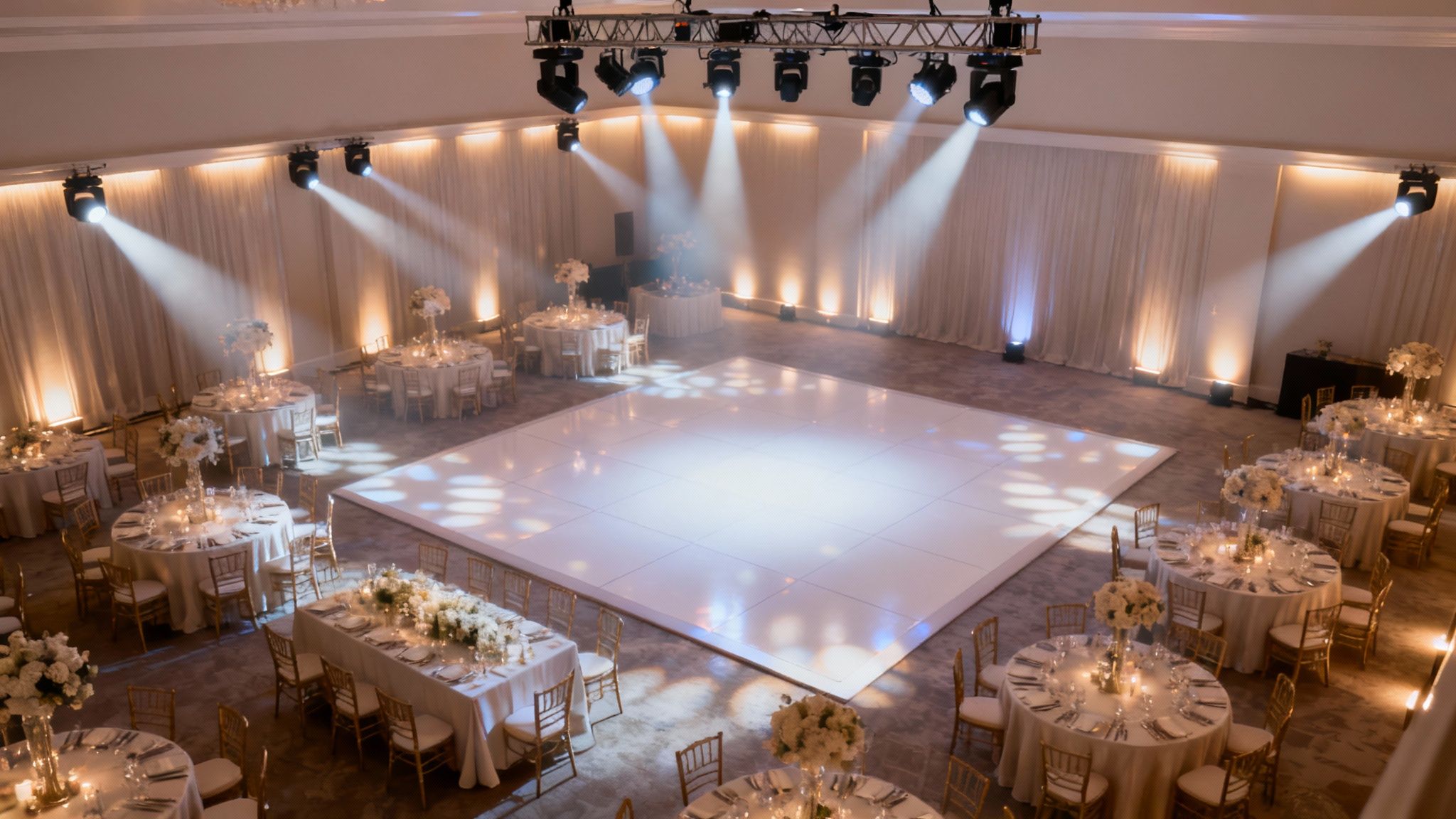
Anyone can plug in a few lights and call it a day. The real secret to a stunning wedding reception? A lighting plan that’s actually planned. A thoughtful design ensures your DJ lights for the wedding aren't just a random light show, but a key part of creating an unforgettable atmosphere. It's what separates a generic setup from a professional, polished vibe.
Think of it as telling the story of your evening through light. The lighting should feel different during dinner than it does when the dance floor is packed. This means layering different fixtures and, more importantly, programming them to transition seamlessly between the big moments of the night.
Mapping Out the Key Moments
A wedding reception isn't one long party; it's a series of distinct events. Your lighting needs to keep up. Just setting your lights to "party mode" and walking away is a missed opportunity. A great lighting pro will anticipate the flow of the evening.
-
Guest Arrival & Cocktail Hour: This is all about a warm, inviting welcome. Static uplighting in your wedding colors can set the mood instantly, giving guests that "wow" moment as they enter. The vibe here is elegant and sophisticated—save the party lights for later.
-
Grand Entrance: Time to build some energy! This is the perfect spot to use moving heads as a "spotlight" that follows you into the room. It’s a simple touch that adds a ton of drama and puts the focus squarely on you.
-
Dinner & Speeches: The lights should take a backseat here. Lowering the intensity and sticking to soft, warm tones keeps things intimate. A pro tip is to use pin spots on your table centerpieces, which adds a touch of class without distracting from the toasts.
-
First Dance: Let’s make this moment magical. A dedicated spotlight on the happy couple is a must. To really elevate it, you can add a slow-moving gobo pattern on the floor or walls for a beautiful, romantic texture.
-
Party Time: Okay, now you can bring the energy. Once the dance floor is officially open, it's time to unleash everything. Fast-moving heads synced to the beat, vibrant color washes, and maybe even a classic mirror ball will get everyone moving.
Navigating Venue and Technical Needs
Before you fall in love with a grand lighting scheme, you've got to deal with the practical stuff. Every venue has its own quirks and rules, so getting ahead of this is crucial.
Start by talking to the venue coordinator about power. Seriously. A professional lighting rig can pull a lot of juice. Your DJ or lighting tech needs to know where the outlets are and, ideally, get access to dedicated circuits so you don't blow a fuse in the middle of "Don't Stop Believin'."
Expert Insight: Always ask your lighting vendor if they've worked at your venue before. An experienced pro will already know the layout, power limitations, and any specific restrictions, saving you a massive headache on your wedding day.
Venue restrictions are another big one. Some historic buildings might not allow haze or fog machines (which are what make light beams visible). Others might have strict rules about where you can place trussing or stands. Getting these details sorted out early helps your lighting designer create a plan that's both incredible and compliant. If you need more inspiration for working within a space, you can explore tons of different wedding lighting ideas that fit all kinds of venues.
This demand for immersive, well-designed lighting isn't just a trend—it's big business. The global DJ lighting market was valued at around USD 3.5 billion in 2022 and is expected to keep climbing, mostly because couples want their events to feel unique and atmospheric. You can dig into more of the industry stats over at DataHorizzon Research.
Deciding Between DIY and Professional Lighting
You’ve got a killer vision for your wedding lighting. Now for the million-dollar question: do you go it alone or bring in a pro? This is a classic wedding planning dilemma, and it usually comes down to three things: your budget, your time, and the "wow" factor you're aiming for.
Let's walk through both options so you can figure out what makes the most sense for your big day.
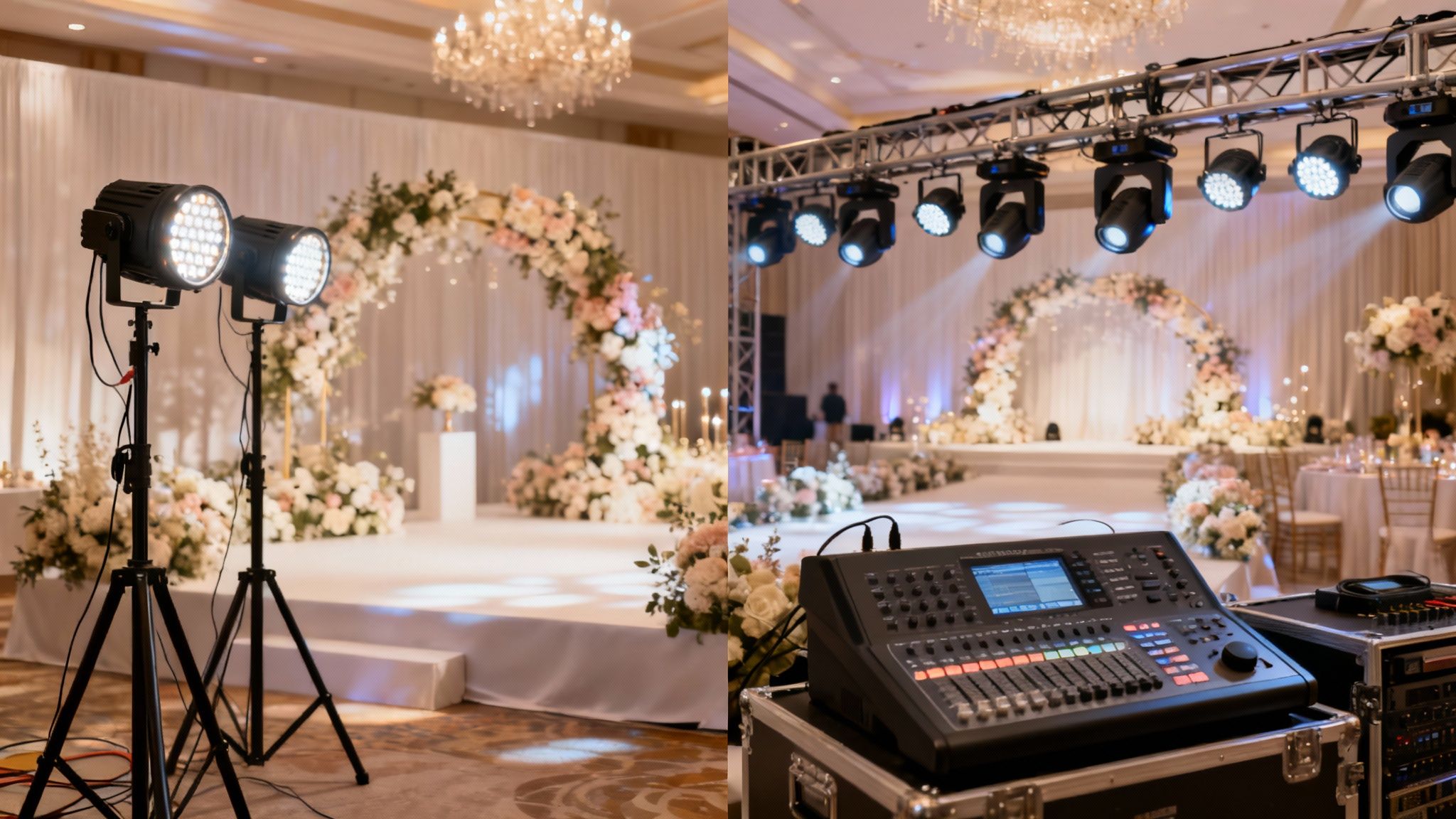
The do-it-yourself path can be really tempting, especially if you're keeping a close eye on the budget. But it's not just about the rental cost—it's about the whole picture. When you're weighing the pros and cons, think about how lighting fits into your overall spending plan, just like you would when exploring budget-friendly wedding packages.
The DIY Lighting Route
Going DIY puts you in the driver's seat, which is both empowering and, let's be honest, a little terrifying. You're suddenly the person in charge of renting, picking up, setting up, programming, and eventually tearing down every single piece of equipment.
A Reality Check for DIY:
- Your Time: How many hours do you really have on your wedding day (and the day before) to dedicate to setting up and testing lights? Be brutally honest with yourself.
- The Tech Stuff: Are you comfortable messing with DMX controllers, running power cables, and figuring out mounting hardware?
- The Gear: Do you know a wash light from a moving head? Figuring out what to rent is a big first step. Checking out guides on event lighting rentals can get you started. You can see some options at https://1021events.com/event-lighting-rentals/.
- The "What Ifs": What’s your backup plan when a light fizzles out or a cable goes bad right in the middle of the reception?
If you're thinking simple—maybe just a few static uplights to add a pop of color—then DIY is totally doable and a great way to save some cash.
Hiring a Professional Lighting Expert
On the other hand, hiring a pro is an investment in your own sanity. Whether it's a dedicated lighting designer or a DJ who offers a killer lighting package, you're not just paying for the gear. You're paying for their expertise and the peace of mind that comes with it.
A professional knows how to build a dynamic light show that transforms the space as the night goes on—from a soft, romantic glow during dinner to a full-on, high-energy dance party later.
The Pro Advantage: A real expert handles all the technical headaches. They know how to manage power loads so you don't blow a fuse, and they know which colors will look amazing in your photos. They take care of all the logistics, so you and your family can just show up and enjoy the party.
This kind of expertise is a big reason why the global DJ equipment market was valued at USD 0.63 billion in 2024 and keeps on growing. As gear gets more sophisticated, professionals can create truly stunning and reliable experiences for events like weddings. If you're curious, you can find more insights about this growing market on marketresearchfuture.com.
Bottom line? If your lighting vision is anything more than basic, or if you just want a completely hands-off, stress-free experience, hiring a pro is the way to go.
Key Questions to Ask Your Lighting Vendor
So you've found a vendor whose style you love—fantastic! Now it's time to dig into the nitty-gritty. Whether you're booking through your DJ or a separate lighting company, asking the right questions now is the best way to prevent headaches on your wedding day. This isn’t just about the price tag; it’s about making sure their services, logistics, and creative vision are a perfect match for yours.
Think of this as an interview for a creative partner. You need to feel confident they can handle all the technical details so you can just enjoy the party. A few smart questions will help you vet vendors and find the perfect team to bring your vision to light.
Logistics and Experience
Before you start dreaming up color schemes and gobo designs, you have to cover the basics. A vendor's experience, especially with your venue, can be the difference between a seamless setup and a chaotic one.
-
Have you worked at my venue before? This is a golden question. If the answer is yes, they already know the layout, where the outlets are, and what potential challenges to plan for. If it’s a no, ask if they’ll do a site visit beforehand. It shows they're proactive.
-
What are your power requirements? Don't skip this one. Professional DJ lights for a wedding can suck up a lot of juice. You need to be 100% sure the venue can handle their setup without tripping a breaker in the middle of your first dance.
-
Who is responsible for setup and teardown? You want to hear that their team handles every single thing. Get a rough timeline from them, too. The last thing you need is to be asked about cleanup when you're making your grand exit.
Key Takeaway: A vendor who already knows your venue is a huge plus. It means they're prepared for the space's unique quirks and can plan accordingly, leading to a much smoother, stress-free day for everyone.
Packages and Customization
Alright, now for the fun stuff. Let’s make sure you get exactly what you're picturing in your head. Vague package names can be tricky, so it’s your job to get them to clarify exactly what you’re paying for.
Ask for a detailed breakdown of their packages. Don't let them get away with just "Gold Package" or "Premium Dance Floor."
-
What specific fixtures are included in each package? Get specific quantities. Does their standard uplighting package include eight lights or twelve? Are you getting two moving heads or four? The details matter.
-
Is a lighting technician present for the entire event? If you want lighting that changes with the mood—soft and romantic for dinner, high-energy for dancing—you need a human at the controls. A set-it-and-forget-it approach won't work for a dynamic event.
-
How much customization is possible? Can you pick the exact shade of amber for your uplighting? Can they design a custom monogram gobo from a sketch you provide? Knowing how much creative input you have is key.
-
Are there any hidden fees? Just ask them straight up. Be on the lookout for travel costs, extra setup fees, or even charges for long extension cords. This ensures the quote they give you is the price you'll actually pay.
Common Questions About Wedding DJ Lights
When you're trying to nail down the perfect vibe for your wedding, a few questions about DJ lighting always seem to pop up. It's totally normal to wonder about the cost, how it'll affect your photos, and what all the different terms even mean. We've been there, so let's clear up the most common questions to help you plan like a pro.
How Much Should I Budget for Wedding DJ Lights?
Ah, the million-dollar question. The honest answer is that it really depends on what you're looking for. A simple add-on from your DJ might just be a few hundred dollars, while a full-blown custom design from a dedicated lighting company can easily stretch into the thousands.
As a starting point, a good rule of thumb is to set aside 5-10% of your total entertainment budget for lighting.
- Basic Packages: These usually cover the dance floor essentials—enough to get the party started.
- Mid-Range Packages: This is where you'll often see room uplighting added, which creates a much more cohesive and elegant atmosphere.
- High-End Packages: Think bigger. This could include custom monogram gobos projected onto the dance floor or even a dedicated lighting technician to run the show all night.
Whatever you do, always ask for an itemized quote. It's the only way to know exactly what you're paying for and avoid any last-minute surprises.
Will DJ Lights Ruin My Wedding Photos?
This is such a valid concern, but the short answer is no—when it's done right. In fact, professional lighting should make your photos better, adding depth, color, and a vibrant energy that looks incredible on camera.
The real trouble comes from cheap or poorly placed lights. You know the ones—those little dot-pattern lasers that spray green and red spots all over your faces and the dress you spent a fortune on. The fix for this is simple: communication.
Pro Tip: Make sure your photographer and your lighting person (or DJ) connect before the wedding day. When they're on the same page, they can create a plan that looks stunning both in the room and in your photos, especially for big moments like the first dance. A true professional knows how to build ambiance without ruining the shot.
What Is the Difference Between DJ Lights and Uplighting?
It's easy to mix these two up, but they play very different roles. I like to think of them as two separate layers that come together to create the final look.
Uplighting is all about setting the mood. These are static lights, usually placed on the floor, that wash the walls of your venue with color. They’re perfect for accenting cool architecture or just creating an elegant, immersive feel from the moment guests walk in.
DJ lighting, on the other hand, is pure energy. These are the dynamic, moving lights aimed squarely at the dance floor. We're talking moving heads, color-changing effects, and fixtures that pulse with the beat of the music. Their whole job is to get people hyped up and ready to celebrate. Our guide to wedding dance floor lighting has a ton more ideas on this.
The most memorable wedding designs almost always use both. The uplighting sets that beautiful, elegant scene, and the DJ lights bring the party to life when it's time to dance.
Ready to create a stunning, unforgettable atmosphere for your wedding? The experts at 1021 Events specialize in professional DJ services and custom lighting designs that will transform your venue and keep your guests celebrating all night long. Plan your perfect wedding lighting with us today!
